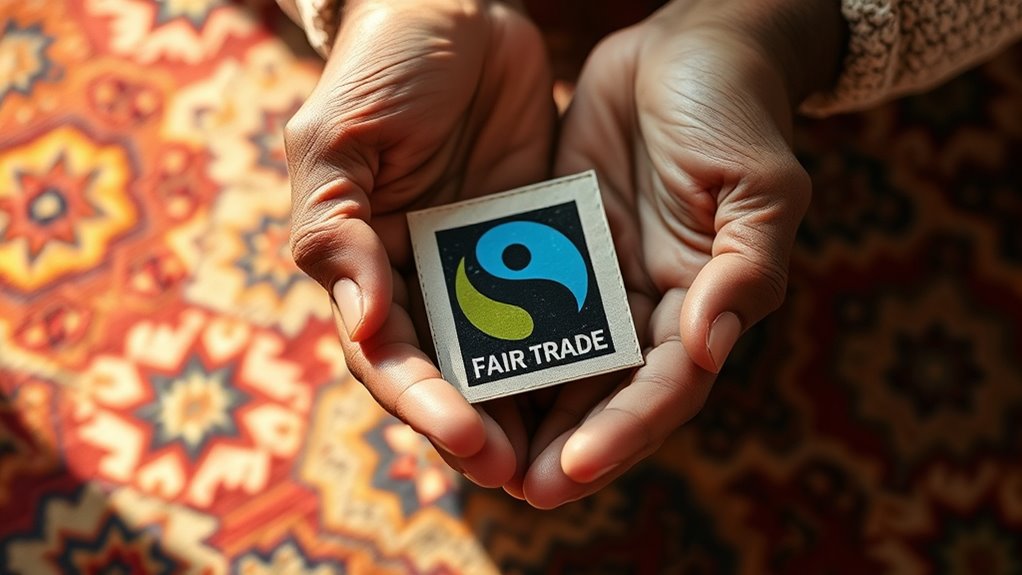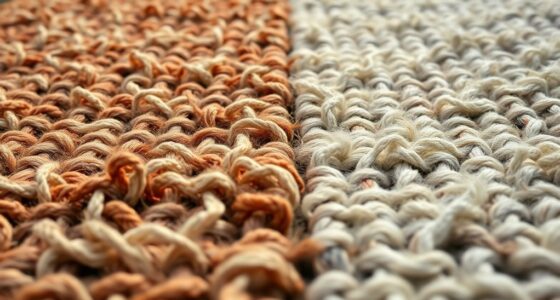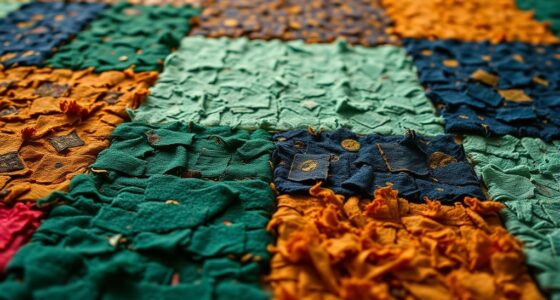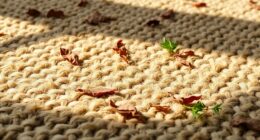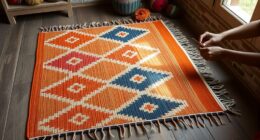To verify if a carpet is fairly traded, check for trusted certification labels from recognized organizations. Look for clear symbols or logos indicating standards for fair wages, safe working conditions, and eco-friendly practices. Confirm the certification number with official sources and verify the certifier is reputable. Investigate the supply chain to ensure ethical sourcing and craftsmanship. Continue exploring to discover more ways to confidently identify authentic, ethically woven carpets.
Key Takeaways
- Look for trusted certification logos from recognized fair-trade organizations on the carpet’s label.
- Verify certification numbers and details through official certifier websites for authenticity.
- Ensure standards specify ethical sourcing, fair wages, and eco-friendly dyeing practices.
- Confirm the supply chain transparency, including raw materials and artisan working conditions.
- Research the certifying body’s credibility and review recent audits or reports for reliability.
Understanding Fair-Trade Certifications and Their Significance
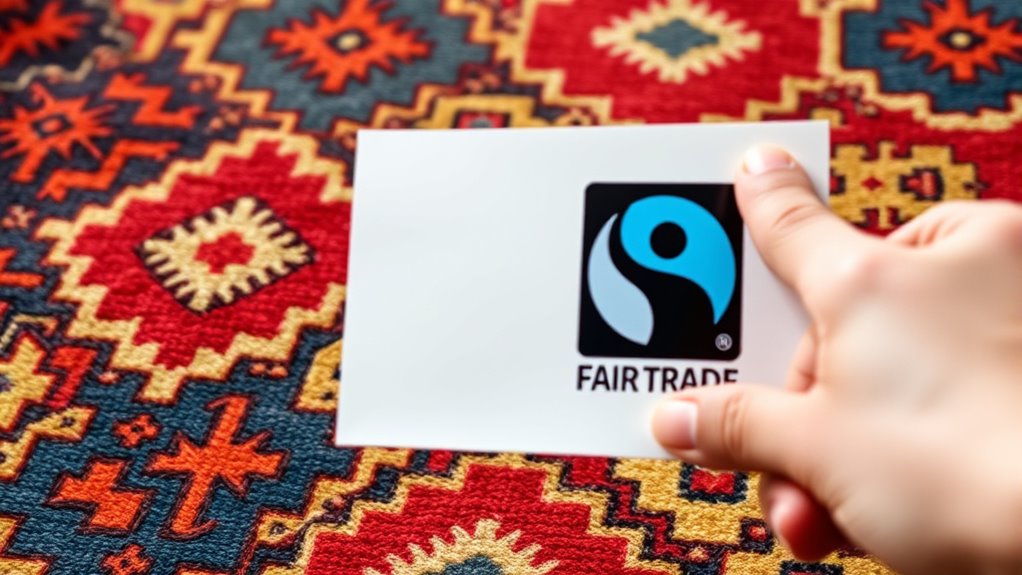
Fair-trade certifications play a crucial role in ensuring that carpets are produced ethically and sustainably. When you see a fair-trade label, you’re supporting artisans’ rights by helping secure fair wages and safe working conditions. These certifications also aim to reduce the environmental impact caused by carpet production, encouraging eco-friendly practices like water conservation and sustainable sourcing of dyes and materials. By choosing fair-trade carpets, you directly contribute to empowering craft communities and promoting responsible environmental stewardship. This certification process guarantees that producers adhere to strict standards, making your purchase more than just a decorative choice—it’s a statement supporting ethical labor practices and minimizing ecological harm. Additionally, understanding payment solutions trends and practices can shed light on how consumer choices influence production standards across various industries. Recognizing the importance of vibrational energy in consumer behaviors can further emphasize how aligning with ethical practices benefits both producers and buyers. Incorporating mindfulness into purchasing decisions can help consumers make more ethical and environmentally conscious choices, reinforcing the significance of fair-trade standards. Awareness of consumer influence is also vital, as it demonstrates how buyers can drive positive change in industry practices. Ultimately, fair-trade certification helps create a more equitable and sustainable carpet industry.
Recognizing Recognized Fair-Trade Certification Labels
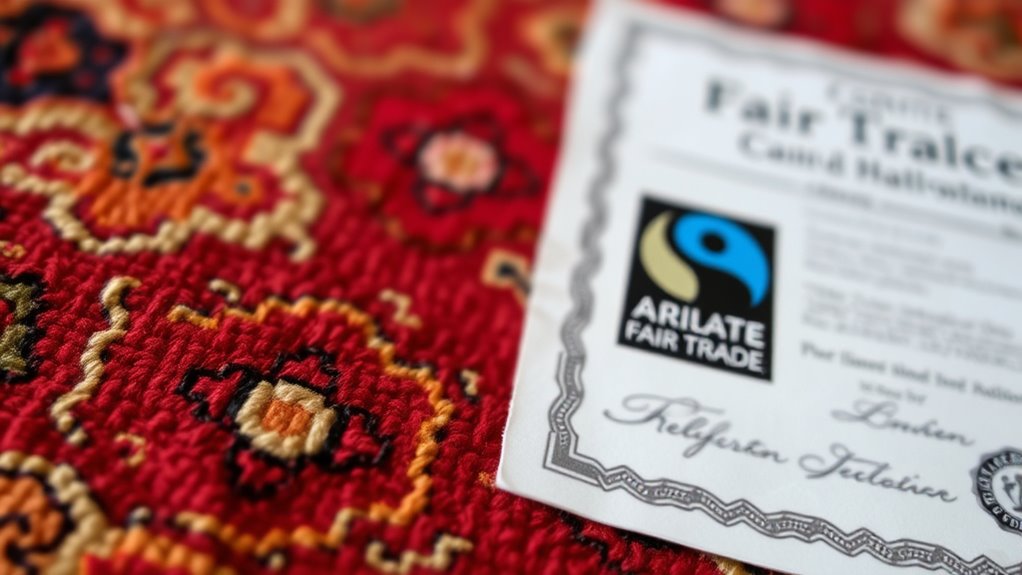
To guarantee you’re supporting genuine ethical practices, it’s important to recognize the trusted labels that certify fair-trade carpets. Look for well-known logos from organizations committed to fair-trade principles, which often appear on product tags or packaging. These labels verify that the carpet’s handwoven craftsmanship meets strict ethical standards, including fair wages and safe working conditions. They also indicate that natural dyeing techniques were used, reducing environmental impact. Recognized labels often feature symbols or text that highlight their credibility. Be aware that some labels are more transparent about their certification process, and understanding wall organization systems can also help you make more ethical choices in home decor. By familiarizing yourself with these trusted seals, you ensure your purchase promotes ethical practices and high-quality craftsmanship. Additionally, understanding the different dog breeds can help you select a pet that aligns with your lifestyle and values. Recognizing fair-trade certification labels is essential to verify the integrity of the ethical claims made by manufacturers.
Verifying Certification Authenticity Through Official Sources
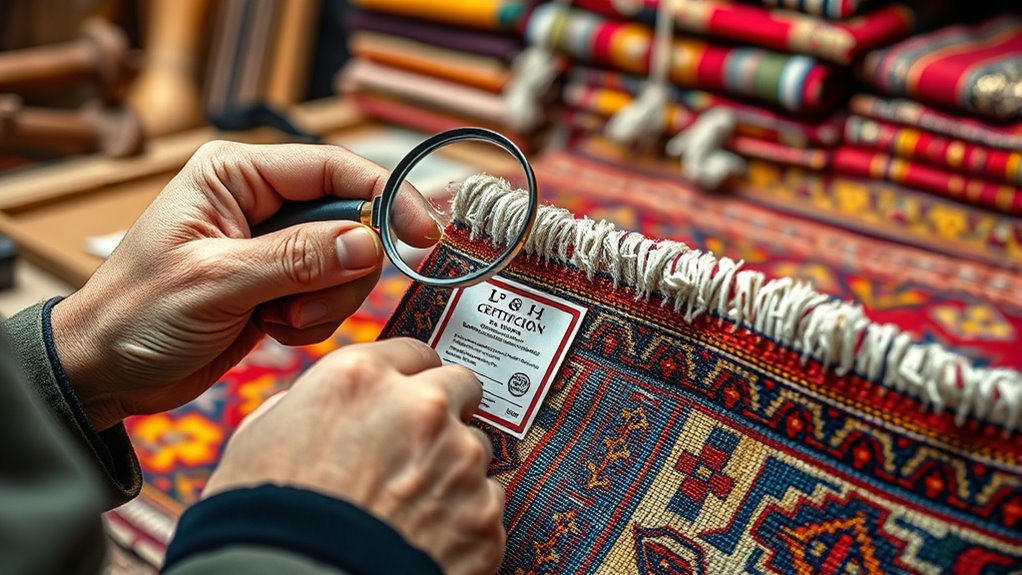
To guarantee a carpet’s fair-trade certification is legitimate, start by checking the certification bodies listed on the label. Then, verify the certification numbers with the official sources or websites provided by those organizations. This simple step helps confirm that the certification is authentic and up-to-date. Additionally, understanding the certification process can help you recognize genuine fair-trade credentials. Confirming that the safety features are in place ensures the product meets safety standards and is reliable. Being aware of the personality traits associated with ethical sourcing can also support making informed purchasing decisions, especially as transparency and trust are vital in ethical practices.
Check Certification Bodies
When verifying a carpet’s fair-trade certification, it’s vital to check the credentials directly with the official certification bodies. This guarantees the certification is legitimate and up-to-date. Contact the organization or visit their website to verify their accreditation status and review recent certification audits. Look for transparency in their processes, as reputable bodies often provide detailed information about their standards and audits. Confirm that the certification body is recognized internationally or by relevant industry authorities. Doing so helps you assess whether the brand maintains transparency and adheres strictly to fair-trade practices. Remember, authentic certification bodies prioritize ongoing certification audits to maintain trustworthiness, so verifying their legitimacy is a fundamental step in ensuring you support truly ethical products. Additionally, referencing certification accuracy from official sources can provide further confirmation of certification authenticity. Checking third-party verification processes can also help ensure the credibility of the certification.
Confirm Certification Numbers
After confirming that a certification body is legitimate, the next step is to verify the specific certification numbers associated with the carpet. This guarantees supply chain transparency and confirms the carpet’s link to artisan fair trade programs. Use the official website or contact the certifier directly to check these numbers against their records. Here’s a quick reference:
| Certification Number | Issued To | Validity Status |
|---|---|---|
| 123456789 | Artisan Cooperative | Valid |
| 987654321 | Fair Trade Carpets Ltd | Valid |
| 456789123 | Weaver’s Guild | Valid |
| 321654987 | Sustainable Weaves | Valid |
Cross-check these details carefully to confirm authenticity and support fair trade practices.
Investigating the Certification Body’s Credibility and Standards
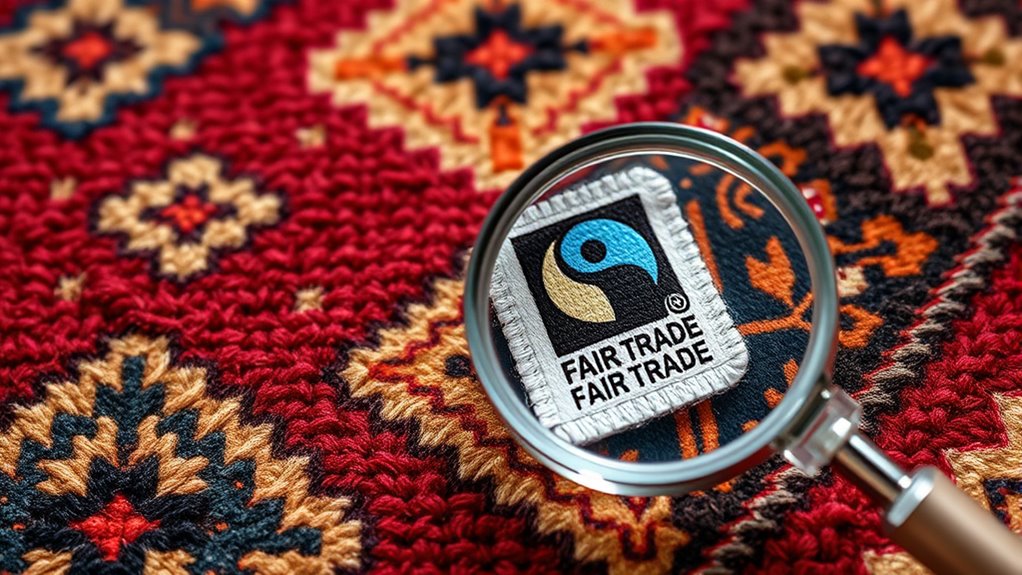
Evaluating the credibility of a certification body is essential to guarantee that the fair-trade standards for carpets are genuinely upheld. You should check if the organization maintains rigorous standards and is transparent about its processes. A credible body often conducts regular audits, ensuring supply chain transparency and fair labor practices. Look for evidence of artisan training programs that develop local skills and improve working conditions. Consider whether the certification body is recognized by reputable industry associations or international fair-trade networks. Transparency in their procedures and a strong track record are good indicators of reliability. Additionally, verify if they publish detailed reports or assessments, which can help you assess their commitment to authentic fair-trade principles. This due diligence ensures your carpet purchase supports genuine ethical practices.
Examining the Supply Chain and Production Practices
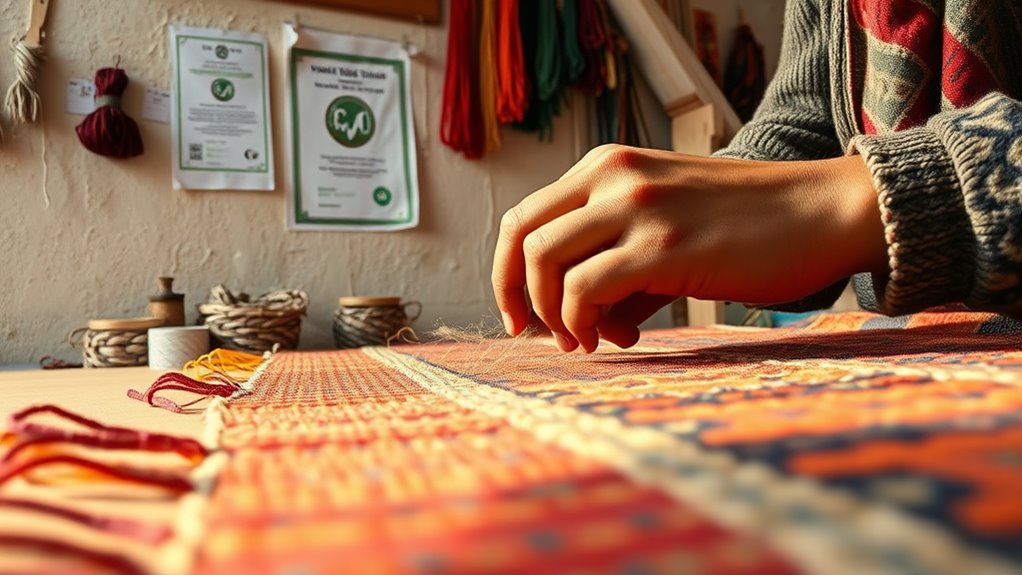
To truly assess the fairness of a carpet’s production, you need to examine the entire supply chain closely. Supply chain transparency reveals whether workers and communities are treated ethically at every stage. Look into how raw materials are sourced and whether suppliers adhere to fair labor practices. Conduct a thorough production process inspection to identify any signs of exploitation, unsafe working conditions, or environmental harm. Ask for detailed information about each link in the supply chain, from fiber harvesting to final weaving. If transparency is lacking or details are vague, it’s a red flag. Ensuring fair-trade principles are upheld requires diligent scrutiny of these practices, confirming that every step aligns with ethical standards and fair labor practices.
Supporting Ethical Weaving: Tips for Informed Purchasing
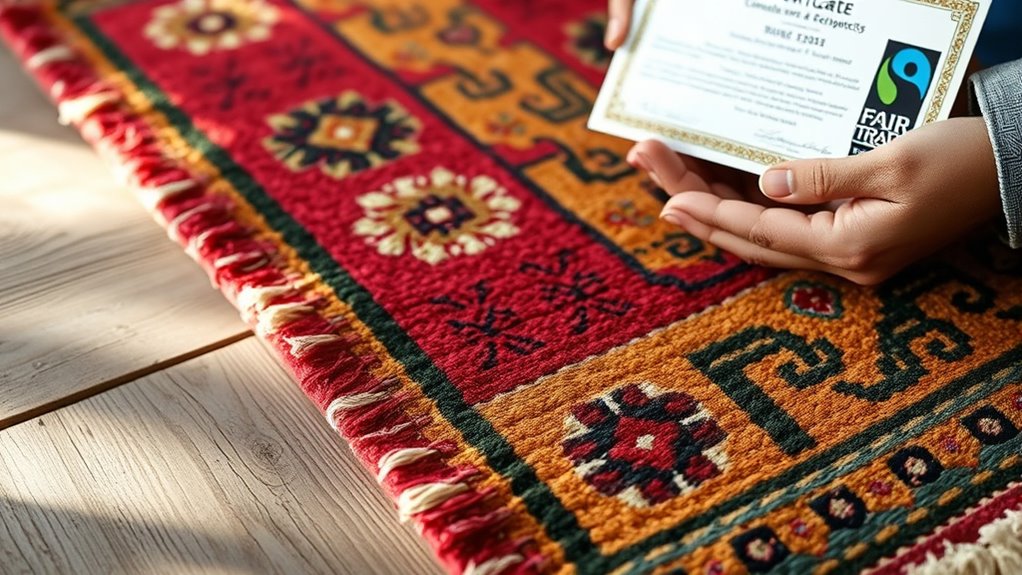
When shopping for carpets, start by recognizing certification marks on labels—they tell you if the product meets ethical standards. Take a moment to research what these certifications mean to guarantee you’re supporting fair and sustainable weaving practices. Being informed helps you make choices that genuinely support ethical craftsmanship.
Recognize Certification Marks
Recognizing certification marks on carpets is essential for ensuring your purchase supports ethical and sustainable practices. These marks verify that the carpet meets fair-trade standards and reflect responsible textile techniques. Look closely at the labels or tags, as they often display recognizable symbols or logos from certifying organizations. Certification marks can also indicate the origin of the materials, ensuring they align with ethical sourcing. Pay attention to details like design patterns, which may reveal traditional or community-based textile techniques. By knowing what to look for, you can confidently select carpets that uphold fair labor practices and cultural authenticity.
- Verify the presence of official certification logos
- Check for symbols indicating eco-friendly or ethical standards
- Confirm that design patterns align with fair-trade origins
- Ensure the label is intact and clearly printed
Research Certification Standards
Researching certification standards is essential for making informed purchases that support ethical weaving practices. By understanding the standards, you guarantee the carpet aligns with fair labor, environmental sustainability, and quality. Look for certifications that specify the use of organic dyes, which reduce harmful chemicals and promote eco-friendly practices. Verify if the standards highlight artisan craftsmanship, ensuring artisans receive fair wages and work conditions that respect their skills. Some certifications set strict guidelines for natural materials and traditional weaving techniques, which protect cultural heritage. Take time to review the certification body’s credibility and transparency. Knowing these standards helps you confidently choose carpets that genuinely support ethical weaving, empowering artisans and fostering sustainable production.
Frequently Asked Questions
How Do Fair-Trade Standards Impact Local Weaving Communities?
Fair-trade standards positively impact local weaving communities by promoting cultural preservation and economic empowerment. When you support fair-trade carpets, you’re helping artisans maintain traditional crafts and guarantee fair wages. This encourages communities to sustain their cultural heritage while gaining financial stability. Your choices directly contribute to empowering artisans, fostering community growth, and preserving unique weaving techniques for future generations, making ethical buying a meaningful and impactful decision.
Are There Any Hidden Costs Associated With Certified Fair-Trade Carpets?
Think of fair-trade certification as a trustworthy lighthouse guiding you through foggy waters. While it illuminates ethical practices, hidden costs like certification fees can sometimes feel like hidden rocks beneath the surface. These costs might add up, making the carpets pricier. However, they often cover essential quality checks and fair wages. So, though there are some hidden costs, they support transparency and ethical standards, ensuring your purchase truly benefits artisans.
Can Non-Certified Carpets Still Meet Ethical Production Criteria?
You might wonder if non-certified carpets can still meet ethical sourcing standards. While certification legitimacy is important, some artisans follow ethical practices without formal labels. To guarantee ethical production, look for transparent supply chains, fair wages, and sustainable materials. Research the company’s values and practices, ask questions, and seek detailed information. This way, you can support ethical weaving even without official certification, aligning with your values and promoting fair trade principles.
How Often Are Fair-Trade Certifications Renewed or Reassessed?
You might wonder how often fair-trade certifications are renewed or reassessed. Certification renewal typically occurs annually, but reassessment frequency can vary depending on the certifying body and specific standards. Regular reassessments guarantee that producers meet ongoing ethical and quality criteria. Staying informed about these schedules helps you verify a carpet’s certification status and trust that it continues to meet fair-trade standards over time.
What Questions Should I Ask Artisans About Their Working Conditions?
Imagine a vibrant tapestry, each thread representing artisan welfare and a safe working environment. You should ask artisans about their working hours, pay, and access to healthcare to gauge their well-being. Inquire if they work in a space that’s clean, safe, and free from exploitation. These questions reveal the true story behind the craftsmanship and help guarantee fair treatment and ethical working conditions.
Conclusion
When shopping for carpets, always verify fair-trade certifications through official sources to guarantee ethical practices. Did you know that only about 20% of fair-trade claims are genuinely certified? By checking the certification body’s credibility and understanding the supply chain, you support fair wages and sustainable craftsmanship. Making informed choices not only benefits artisans but also promotes a more ethical and transparent industry. Your vigilance can truly make a difference in fostering fair and responsible weaving practices.
